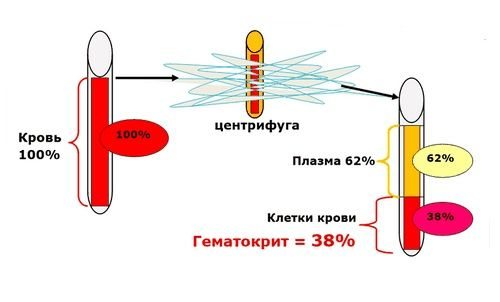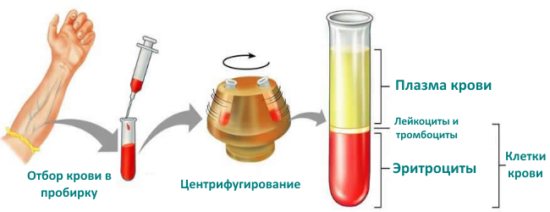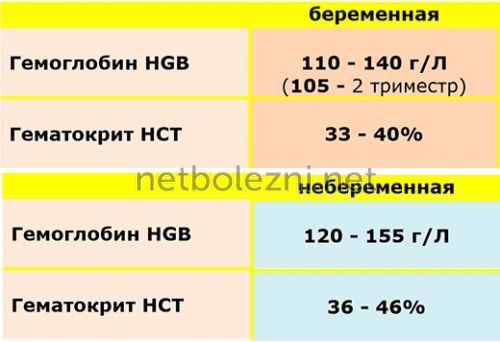Hematocrit is a barely noticeable to ordinary people, but extremely important indicator of the state of the blood. The indicator, in simple terms, expresses the ratio of red blood cells (red cells) to a single volume of total blood (usually determined as a percentage). Based on the hematological parameter, we can conclude about the viscosity of the blood - the higher the hematocrit level, the thicker the biomaterial.
It should be mentioned that in rare cases, such an index shows the concentration of all formed elements along with platelets and leukocytes. These blood components are represented in a minimal amount compared to the same red blood cells, so the data obtained is not so different from the classical measurement.
Conducting a hematological study
In order to find out the value of hematocrit, doctors can remove a small portion of blood from both the finger capillary and the cubital vein. In laboratory conditions, a substance that prevents premature clotting - an anticoagulant - is added to the sample. The test tube is then placed in one of the centrifuge cells and the apparatus is activated.
The drum begins to accelerate around its own axis, and as a result of the centrifugal force, heavier blood cells (red blood cells) settle at the bottom, and a light liquid appears on the surface - translucent plasma. Other components (leukocyte cells, platelets) form a thin intermediate film.
After completing this stage, the specialist assesses the level of red blood cells in the blood using special markings and writes down information about the hematocrit on a form. Some clinics use modern devices to detect blood counts that perform the counting function automatically. The results of the study are most often given to the attending physician who referred the patient for the procedure the very next day.
The principle of establishing the level of hematocrit in the blood
What is accepted as the norm?
The hematological parameter depends mainly on 2 factors - gender and age:
| Age category | Hematocrit content in blood (%) | |
| Among women | In men | |
| Up to a month | 40–67 | |
| 2–3 months | 32–44 | |
| 4–12 months | 35–44 | |
| 2 years–6 years | 36–41 | |
| 7–12 years | 33–44 | |
| 13–17 years old | 35–44 | 36–48 |
| 18–45 years old | 36–46 | 39–48 |
| 46+ | 35–47 | 40–50 |
The blood count increases to the maximum in infants, which is considered a completely biologically substantiated phenomenon. On forms, hematocrit may be referred to as HCT. As a rule, an index over 52–55% means a sufficiently increased concentration of red blood cells, so detection of such a hematocrit should be a reason for prescribing a repeat analysis and additional procedures.
If, against the background of increased blood viscosity, a person experiences swelling, dizziness, nausea, headaches, difficulty breathing and numbness of the limbs, then you need to make an appointment with a doctor as soon as possible. Such a clinical picture often indicates the beginning of pathological transformations in the body. A sharp deterioration in the condition of the nail plates, skin and hair can also manifest itself.
Normal values
Low hematocrit is a deviation from the norm, which is individual for each person. This means that normal values will differ not only depending on age, but also on gender.
For example:
- in newborns – from 35 to 65%
- in infants under 1 year of age, rates range from 32 to 40%
- for children from one to 11 years of age, the permissible values are 32-41%
- in adolescence: for girls – 35-45%, and for boys – 34-44%
- in women: from 18 to 45 years old – 39-50%, over 45 years old – 35-46%
- in men: from 18 to 45 years old – 35-45%, over 45 years old – 40-50%.
If the hematocrit is reduced to 30-35% in an adult, then this is an indication for constant monitoring by a therapist. Values from 24 to 29% are considered a painful condition that can only be eliminated with medication.

Determination of hematocrit in the laboratory
Causes of low hematocrit
A decrease in hematocrit in a blood test may indicate the following anomalies:
- anemia (anemia);
- cystitis;
- bleeding (external and internal);
- hemolysis (rapid destruction of red blood cells);
- severe poisoning with toadstool or heavy metals (antimony, zinc, cobalt, mercury, lead);
- pathological self-destruction of blood cells in malaria and typhoid fever;
- inflammation of the gastrointestinal tract, disrupting the absorption of iron into the blood;
- Hodgkin's disease (malignant degeneration of lymphoid tissue);
- overhydration (excessive amount of fluid in the body).
Sometimes a low hematocrit in the blood is due to hyperproteinemia (excess protein). This disease sometimes accompanies chronic infections, sarcoidosis and autoimmune diseases (systemic lupus erythematosus, rheumatoid polyarthritis). Also, the hematological indicator may be lowered due to damage to certain organs that are directly related to the production or purification of blood:
- Bone marrow. Hemoblastosis, myeloma.
- Liver. Fatty degeneration, cirrhosis and hepatitis in the active phase.
- Kidneys. Glomerulonephritis, renal failure, paresis and stenosis (narrowing of the lumen) of the renal artery.
Poor nutrition and adherence to a strict diet can lower the hematocrit in the blood. The body does not receive enough vital substances (B vitamins, iron), as a result, erythropoiesis (the process of formation of red blood cells) slows down significantly.

With a low hematocrit in the blood, the patient experiences malaise, shortness of breath, rapid heartbeat, pale skin, lethargy, drowsiness, aching headaches and increased fatigue
It is not often that a low index indicates that there are parasitic life forms in the human body that feed on blood or weaken red blood cells. Uninvited guests may include:
- protozoa (unicellular): malarial plasmodium, toxoplasma, hemosporidia, trypanosome, dysenteric amoeba;
- helminths (worms): guinea worm, mansonella, tapeworm, opisthorchis, whipworm, echinococcus, roundworm.
In medical practice, there are cases of false results in the form of an underestimated hematocrit. In completely healthy people, it can be observed if blood thinning was previously carried out.
Vessels that are too compressed with a tourniquet during the removal of a blood sample or the procedure is performed with the patient in a supine position also contribute to a decrease in the corresponding indicator. For those who stubbornly fight a malignant tumor, the blood sometimes becomes thinner after chemotherapy and the use of cytostatics.
Symptoms
Symptoms of a pathological source come to the fore among clinical manifestations, which is why a decrease in hematocrit may go unnoticed.
However, this problem has several specific external signs, among which are:
- systematic malaise;
- causeless shortness of breath;
- fatigue;
- increased heart rate;
- decreased performance;
- constant headaches;
- pale skin;
- deterioration of hair condition.
The above symptoms are most pronounced in pregnant women, children and people suffering from anemia.
What causes a high rate?
Pathologies in which the hematocrit in the blood is increased include:
- diabetes;
- burn disease;
- pneumonia;
- pulmonary and heart failure;
- chronic obstructive bronchitis;
- tuberculosis;
- leukemia (malignant lesion of the hematopoietic system);
- ischemic kidney and heart disease;
- bronchial asthma;
- intestinal obstruction;
- state of shock;
- peritonitis (inflammation of the peritoneum);
- Vaquez disease or erythremia (benign formation that enhances the synthesis of blood cells).
High parameters are also characteristic of some renal diseases - acute or chronic polycystic disease, Wilms tumor and hydronephrosis. The latter anomaly is a pathological dilation of the calyces and pelvis, which leads to kidney dysfunction.
Severe dehydration (loss of fluid) contributes to blood thickening, requiring urgent medical intervention. In the absence of emergency care, the patient may die from dehydration. Illnesses accompanied by prolonged diarrhea, profuse sweating and vomiting can cause such a harmful reaction.
At a critical level of water in the body, protective mechanisms are activated to force fluid to be removed from the bloodstream. Thus, the plasma reserves in the blood are sharply depleted, the number of red blood cells remains unchanged, and the concentration of these cells is greatly overestimated. Blood thickening occurs.
The amount of hematocrit is especially affected by long-term use of several groups of medications - diuretics (diuretics), anabolics and glucocorticosteroids. The hematological parameter may be elevated if a person has developed anemia, which provokes swelling and an increase in red blood cells. Among such deviations is megaloblastic anemia.

Prolonged overstrain of the central nervous system (for example, sustained stress) also increases the hematocrit content in the blood
Non-pathological causes of an increase in viscosity index are represented mainly by the following factors:
- deficiency of iron-containing foods in the diet;
- menstrual cycle;
- adherence to the pastel regime for a long time;
- the presence of morbid obesity;
- age-related changes in elderly people.
Thick blood is observed in heavy smokers and citizens who abuse alcoholic beverages. At significant elevations, the volume of oxygen cannot be called sufficient for the full functioning of the body. It follows that a completely understandable increase in hematocrit can be detected in those who:
- flies regularly on airplanes;
- works in high mountain areas;
- engages in rock climbing and mountaineering;
- lives in the mountains.
Divers who constantly dive to depths with special equipment also sometimes have a slightly elevated blood count.
Diagnostics
Only a hematologist can detect a decrease in hematocrit in the blood based on the results of a general clinical or biochemical blood test.
Such a diagnostic laboratory test includes several manipulations:
- first of all, it is necessary to collect biological fluid;
- transferring the material into a sterile flask;
- direction to a centrifuge for an hour and a half;
- separation of blood into its component parts.

Blood analysis
Then the specialist needs to carefully study the material being studied and decipher the results. Only after this will all information be transferred to the attending physician who prescribed such an examination.
Sometimes it is possible to get false positive results.
This occurs in the following situations:
- drawing blood from a bedridden person;
- carrying out the procedure during menstruation;
- removal of material from the area where an intravenous infusion was recently performed;
- blood thinning with medications;
- compression of veins with a tourniquet for a long time.
In this situation, you need to take the test again.
In some cases, an additional blood test for hemoglobin may be required. This is necessary in controversial cases. Such a test can accurately indicate either anemia or pregnancy.
To search for other sources that the hematocrit is below normal, the therapist should independently carry out several activities, namely:
- get acquainted with the medical history to identify chronic diseases;
- collect and analyze life history to confirm or refute the influence of harmless sources;
- assess the condition of the skin;
- measure heart rate indicators;
- conduct a thorough physical examination of the patient;
- interview the patient in detail to obtain a complete picture regarding the clinic: sometimes this helps to accurately determine the provoking disease.
A further laboratory and instrumental diagnostic program will be developed individually for each patient based on the complaints presented.
Preparing for diagnosis
Preparing for a blood test involves few restrictions. So, a day before the procedure, a taboo is established on fast food and food with a high percentage of fat content. Alcohol is excluded. Any type of physical activity should be avoided.
The study is carried out on an empty stomach, so you should refrain from eating food for at least 6-7 hours. You should drink water only when necessary. When using medications that change blood viscosity (anticoagulants, non-steroidal analgesics), you must inform your doctor in advance.
For 2 hours before the analysis, it is recommended to monitor your mental balance and under no circumstances smoke. It is undesirable to donate blood for hematocrit during and immediately after an acute viral infection, menstruation, and large blood loss as a result of injury. These conditions can distort the patient's diagnostic picture.
Features of the indicator in children
A high hematocrit in the blood of a child under 1 year of age is normal. If, after the baby’s first birthday, the tendency for this parameter to increase continues, then parents should take care of making an appointment with a pediatrician to determine the reasons. In some situations, a high content of red blood cells in the blood is typical for children under 13–16 years of age, whose height seriously exceeds the average for their age category.
Many cases of deficiency or excess of hematocrit in a child are explained by individual characteristics, poor diet, sedentary lifestyle or constant dieting (teenage girls are especially guilty of this). Otherwise, their pathological causes are similar to those of adults.
The most common diseases in children are mild anemia and helminthic infestation. Those. all of the above problems that are responsible for changes in blood composition are completely reversible, although this does not mean that fluctuations in hematocrit should be ignored.
Hematocrit is below normal - what does this mean?
A low hematocrit in an adult indicates a reduction in the number of red blood cells in the blood. In this case, the doctor will prescribe additional laboratory tests and instrumental diagnostic methods. Among the laboratory indicators, it is important to determine: the level of iron and ferritin, as well as evaluate the biochemical parameters of the blood. Of the instrumental methods, it is preferable to conduct an ultrasound examination of the digestive organs, liver and pelvis. Based on the results of a comprehensive examination and the patient’s collected medical history, the doctor determines the cause of the low hematocrit.
It should be borne in mind that if a woman submitted biomaterial for analysis during menstruation, then the hematocrit is below normal - this is a standard phenomenon. During this period, the woman loses a certain amount of blood, which means the level of red blood cells decreases somewhat.
It is important to follow the rules for preparing the patient, as well as taking and transporting biomaterial. During venipuncture, destruction of red blood cells in the tube (hemolysis) may occur. For example, due to strong or prolonged compression of the site of biomaterial collection with a tourniquet or due to incorrect storage temperature of the collected blood. The readings obtained cannot be considered reliable, and the patient will definitely need to take the biomaterial again.
Why does the state of the blood change during pregnancy?
The viscosity index in pregnant women is almost always slightly lower than standard indicators - about 30–35.5%, with the generally accepted norm being 36–46%. This phenomenon is associated with a natural increase in the amount of plasma against the background of a constant level of red blood cells. Exceeding the parameters, in turn, may indicate insufficient water intake, prolonged bowel disorder and chronic stress.

Often, excess hematocrit in the blood of pregnant women appears due to daily abuse of salty foods and sodium chloride (table salt)
Since hematological abnormalities can signal serious disorders (late toxicosis, hormonal imbalance, abnormal kidney function), if a high hematocrit is diagnosed, you should immediately visit your doctor.
Danger during pregnancy
During pregnancy, NCT levels should be constantly monitored: to avoid the development of anemia, doctors prescribe systematic testing. In this case, there are several reasons for low HCT levels:
- pregnancy a short time after a previous birth;
- early age of the expectant mother;
- pregnancy with multiple fetuses;

- severe toxicosis;
- insufficient consumption of foods containing iron;
- anemia was diagnosed before pregnancy.
If left untreated, the following consequences are possible:
- premature birth;
- postpartum depression;
- underweight baby;
- anemia of the newborn;
- blood loss during childbirth;
- the birth of a baby with behavioral problems;
- delayed physical development of the child.

How to lower hematocrit in the blood?
If an overestimated parameter appears due to an unbalanced diet, you should change your usual diet. Approximate requirements for drawing up a complete therapeutic diet are reflected in this table:
| Types of food | Recommended Products | Prohibited or strictly restricted products |
| Fruits and berries | That's it, a special place is given to citruses and sour berries | Bananas, careful use of currants, lingonberries, viburnum, blackberries and mangoes |
| Vegetables and greens | Yellow, orange and red fruits (especially carrots, pumpkins, zucchini and tomatoes) | Green plants (broccoli, cabbage, spinach, zucchini, arugula) |
| Fermented milk and dairy foods | Low-fat sour cream and cottage cheese, Varenets, fermented baked milk, kefir | Powdered and whole milk, sour cream with a high percentage of fat content, butter, cream and cheese |
| Cereals, legumes | Barley, barley, millet, oats in the form of oatmeal, brown rice, corn | All legumes and buckwheat |
| Meat and fish | Fatty varieties of sea fish (mackerel, salmon, trout, tuna) and lean meat (turkey) | Lard, ham, liver, goose, duck, lamb, pork and beef |
| Mushrooms | — | All |
| Seafood | Everything, including seaweed | Black and red caviar |
| Sweets and baked goods | Honey, rye bran bread | — |
| Convenience foods and fast food | — | All |
| Preservation and smoked meats | — | All |
| Spices | Cinnamon, ginger | — |
| Beverages | Pure water, juices without added sugar, herbal teas based on sage, licorice, sweet clover and hawthorn | Soda, coffee, alcohol, black and green tea, pomegranate juice |
If necessary, the doctor can prescribe medications that reduce hematocrit and normalize blood viscosity. Often among them appear:
- anticoagulants (Heparin-Agrikhin 1000, Warfarex, Clexane, Sinkumar);
- antiplatelet agents (Curantil, Ticlopidine);
- NSAIDs (Aspirin).
In some cases, it is necessary to resort to special medical procedures such as erythrocytopheresis. In addition to the above, it is worth noting that the positive result will be more noticeable if you start doing physical exercise every day (even walking will do) and get rid of dangerous bad habits - alcoholism and smoking.








